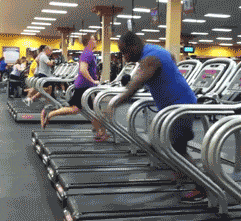1) One of the best things about PRI is their interdisciplinary approach. They’ve done a great job at providing holistic care. Specifically, PRI Vision is putting out some great stuff. PT’s have been stuck advising the same ergonomics with the same reasoning for the past 30 years. Heidi Wise goes over a more methodical way to address your patient’s ergonomics (Part 1 & Part 2).
2) Kevin Carr goes over some great Row Progressions. Use these for your patient. Use these for yourself in the gym.
3) The language you use with your patient has a huge impact. Be positive and optimistic. Don’t talk over their heads. Don’t scare them with patho-anatomy and diagnoses.
4) Mike Boyle clears up some things on ACL “prevention”. “The bottom line is that a good strength and conditioning program is also the best ACL prevention program.”. This article is a must read for anyone that works with ACL patients. Like Charlie always says, Rehab=Training.
5) Gray Cook & Stuart McGill got together for a discussion on their different approaches to movement. Jeff Cubos puts all the reviews in one place here.
6) The Gait Guys have a nice quick review of gait analysis. Knowledge of potential foot pathomechanics helps assessment.
7) Anything that the body does can be chased back to neuroscience. Here’s a Top 10 Neuroscience TED Talks list.
8) “Why you would want to turn your lat on to reach overhead is a puzzle to me, as it limits shoulder flexion and scapular upward rotation, draws the humerus into internal rotation (closes down the subacromial space), and pulls the spine into an extended position (excessive arching). What folks really should be doing is a subtly posterior tilting the scapula to free up space at the front of the shoulder, and facilitate upward rotation.” – Eric Cressey
9) More evidence for the importance of scapula upward rotation.
10) Sleep is an important variable of recovery. Read about it in this series.
11) Developmental Stability is a big part of what I do. It’s natures perfect self-limiting exercise. It’s the hominin’s first SAID principle. It’s something every patient can benefit from.
12) Neuroplasticity is a gift. This is a long read, but well worth it. “Neuroplasticity is an intrinsic property of the human brain and represents evolution’s invention to enable the nervous system to escape the restrictions of its own genome and thus adapt to environmental pressures, physiological changes, and experiences.” -Dr. Alvaro Pascual-Leone
13) A nice quick review of Andreo Spina’s course – Functional Range Conditioning.
14) The importance of breathing is often understated. If your patients can’t breath right, they’re going to have a bad time. Seth Oberst goes over breathing in his 4 part series (I, II, III, & IV).
15) Here’s a nice EMG chart summarizing the glute med activity with specific exercises. The side-plank wins. But keep in mind, EMG studies should be taken with a grain of salt:
1) Do you want a stabilizing muscle firing near a full maximal contraction (strength vs stability, timing vs. force, efficiency, task purpose)?
2) Too many variables to consider with the subjects (exercise history, potentially influencing impairments, past injuries, motivation, etc.). Keep it individualized; not everyone will elicit 74% MVIC of their glute med during the side plank.
3) The reductionistic isolated muscle approach can cause a blunder by overlooking the complexity of movement patterns and biomechanics.
16) “Don’t believe that the neck is connected to the core? Try lifting your head up in supine without activating your core. It’s impossible.”-What I tell patients that don’t buy into the proximal influence
17) “Diffuse noxious inhibitory control (DNIC) is one of several varieties of “descending modulation”, by which the brain alters the amount of nociception (pain) signal coming in.”
18) Gray Cook wrote a great piece about the new Standord University strength and conditioning approach. Here’s 2 articles (1, 2) on their approach and how they’ve reduced injuries by 87%.
19) Top 3 Tweets of the Month
- Emily Soiney – The key to the Frontal door is in the Sagittal lockbox. #PRI
- Seth Oberst – Hip impingement not just structural issue. We can unimpinge many athletes with mobility and spinal control. Don’t just rush to surgery.
- Craig Liebenson – “FMS is not a biomechanical or mechanism of injury screen. It evaluates sensory input.”
20) When you can’t run outside, you have to find a way to make the treadmill interesting.





Good articles on PRI, however I am interested to read that they want knees slightly higher than hips, I have read and suggest the opposite,level or hips slightly higher to encourage lumbar neutral/lordosis and so avoid lumbar flexion